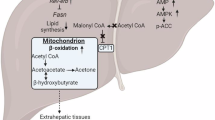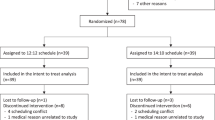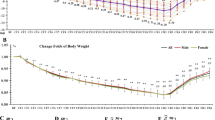Abstract
Studies of prolonged fasting produced spectacular weight loss and demonstrated that ketone bodies rise for approximately three weeks before stabilizing as production and utilization rates equilibrate. Although starvation is no longer an accepted obesity treatment, an extended period of fasting is the basis of time-restricted eating which produces metabolic benefits. Nevertheless, the pattern of change in ketone bodies with time-restricted eating has never been investigated. We collected weekly fasting measures of breath acetone from subjects (N = 60) who were on an eight-week, calorie-restricted diet and were randomized to different time-restricted eating windows. Subjects participating in a 14-hour fast, 10-hour eating window (14:10) lost more weight than subjects participating in a 12-hour fast, 12-hour eating window (12:12) as previously reported (Nutr Diabetes 2021; 11(1): 6). Ketone bodies assessed via breath acetone showed an increase for the first three weeks without a significant difference between groups. From weeks four to eight, breath acetone levels were lower in the 14:10 compared to the 12:12 group (between group difference: 5.45 ± 2.1 parts per million, mean ± SE, p = 0.012). We show for the first time that ketone bodies decrease after a period of adaptation to time-restricted eating of a calorie-restricted diet likely from enhanced fat oxidation and ketone utilization.
This is a preview of subscription content, access via your institution
Access options
Subscribe to this journal
Receive 12 print issues and online access
$259.00 per year
only $21.58 per issue
Buy this article
- Purchase on SpringerLink
- Instant access to full article PDF
Prices may be subject to local taxes which are calculated during checkout

Similar content being viewed by others
Data availability
The datasets generated and analyzed during the current study are not publicly available but are available from the corresponding author on reasonable request.
References
Cahill GF Jr. Fuel metabolism in starvation. Annu Rev Nutr. 2006;26:1–22.
Robinson AM, Williamson DH. Physiological roles of ketone bodies as substrates and signals in mammalian tissues. Physiol Rev. 1980;60:143–87.
McGarry JD, Foster DW. Hormonal control of ketogenesis. Biochemical considerations. Arch Intern Med. 1977;137:495–501.
Newman JC, Verdin E. beta-Hydroxybutyrate: a signaling metabolite. Annu Rev Nutr. 2017;37:51–76.
Puchalska P, Crawford PA. Multi-dimensional roles of ketone bodies in fuel metabolism, signaling, and therapeutics. Cell Metab. 2017;25:262–84.
Peeke PM, Greenway FL, Billes SK, Zhang D, Fujioka K. Effect of time restricted eating on body weight and fasting glucose in participants with obesity: results of a randomized, controlled, virtual clinical trial. Nutr Diab. 2021;11:6.
Musa-Veloso K, Likhodii SS, Cunnane SC. Breath acetone is a reliable indicator of ketosis in adults consuming ketogenic meals. Am J Clin Nutr. 2002;76:65–70.
Tassopoulos CN, Barnett D, Fraser TR. Breath-acetone and blood-sugar measurements in diabetes. Lancet. 1969;1:1282–6.
Anderson JC. Measuring breath acetone for monitoring fat loss: review. Obesity. 2015;23:2327–34.
Owen OE, Felig P, Morgan AP, Wahren J, Cahill GF Jr. Liver and kidney metabolism during prolonged starvation. J Clin Invest. 1969;48:574–83.
Owen OE, Reichard GA Jr. Ketone body metabolism in normal, obese and diabetic subjects. Isr J Med Sci. 1975;11:560–70.
Heymsfield SB, Gonzalez MC, Shen W, Redman L, Thomas D. Weight loss composition is one-fourth fat-free mass: a critical review and critique of this widely cited rule. Obes Rev. 2014;15:310–21.
Heymsfield SB, Yang S, McCarthy C, Brown JB, Martin CK, Redman LM, et al. Proportion of caloric restriction-induced weight loss as skeletal muscle. Obesity. 2024;32:32–40.
Volek JS, Noakes T, Phinney SD. Rethinking fat as a fuel for endurance exercise. Eur J Sport Sci. 2015;15:13–20.
Heymsfield SB, Thomas D, Nguyen AM, Peng JZ, Martin C, Shen W, et al. Voluntary weight loss: systematic review of early phase body composition changes. Obes Rev. 2011;12:e348–61.
Owen OE. Mini-series: paths to discovery. Keton bodies as fuel for the brain during starvation. Biochem Mol Biol Educ. 2005;33:246–51.
Anderson JC, Lamm WJ, Hlastala MP. Measuring airway exchange of endogenous acetone using a single-exhalation breathing maneuver. J Appl Physiol. 2006;100:880–9.
Low J, Falkenhain K. The metabolic mythos of ketones. Nat Rev Endocrinol. 2023;20:66.
Acknowledgements
This study was funded by JC USA, Inc. (Carlsbad, CA). JC USA provided program activities and materials, including discounted prepackaged foods and study equipment, to participants. LEVL devices were provided by Medamonitor, LLC. This work was supported in part by a grant from the National Institute on Aging (CJR, R00AG065419), and from the National Institute of General Medical Sciences of the National Institutes of Health, which funds the Louisiana Clinical and Translational Science Center (FLG, U54 GM104940).
Author information
Authors and Affiliations
Contributions
FLG, PP, and JCA formulated the research aims and designed the study. PP and RB conducted the research. DZ conducted the statistical analysis. CJR wrote the original draft of the manuscript. All authors reviewed and edited the manuscript.
Corresponding author
Ethics declarations
Competing interests
RFB was employed by Medamonitor LLC and JCA served as a consultant for Medamonitor LLC. CJR, DZ, PM, and FLG have no declarations of interest.
Additional information
Publisher’s note Springer Nature remains neutral with regard to jurisdictional claims in published maps and institutional affiliations.
Rights and permissions
Springer Nature or its licensor (e.g. a society or other partner) holds exclusive rights to this article under a publishing agreement with the author(s) or other rightsholder(s); author self-archiving of the accepted manuscript version of this article is solely governed by the terms of such publishing agreement and applicable law.
About this article
Cite this article
Rebello, C.J., Zhang, D., Anderson, J.C. et al. Randomized controlled trial of time-restricted eating: secondary analyses of breath acetone. Int J Obes 49, 1416–1418 (2025). https://doi.org/10.1038/s41366-025-01818-1
Received:
Revised:
Accepted:
Published:
Issue date:
DOI: https://doi.org/10.1038/s41366-025-01818-1



